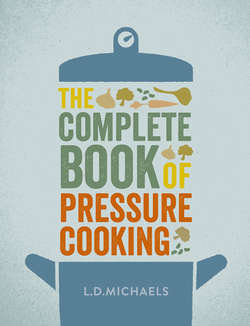Читать книгу The Complete Book of Pressure Cooking - L.D. Michaels - Страница 18
4 HOW TO USE YOUR PRESSURE COOKER
ОглавлениеPressure cookers are used in two ways:
1 as a pressure steamer
2 as a pressure poacher / pressure simmerer.
In the first method, the trivet is placed in the base of the pan and the food is laid over it, or in separators. Water placed below the trivet is boiled up under pressure and converted into high-pressure steam. Food and water don’t come in contact with each other. In the second method, the trivet is not used and the food is cooked in the fluid, which may be either water or stock. The fluid moves only gently – hence the references to simmering and poaching – in this book the terms are used interchangeably.
When cooking solids, the appliance should never be more than two-thirds full in order to let the steam percolate and penetrate thoroughly. When cooking with fluids, the appliance should never be more than half full in order to avoid boiling and frothing up that would clog the escape vent on the pressure valve.
In the ordinary course of pressure cooking, you insert the food, close the lid and place the pan over a high heat. After 2–3 minutes there will be a strong sound of steam coming from the escape vent. At this point, all the air will have been evacuated from the appliance and the inside filled with steam at ordinary pressure; the internal temperature will be 100°C (212°F).
You then bring the pressure up either by moving the appropriate lever or by putting on the weights. Your instruction book will tell you how. For a while the cooker will be silent; then you should hear the escaping steam again. Some cookers have a special indicator, or the valve starts to murmur or rotate. This means that the internal pressure is now up to full pressure. You should then reduce the heat to keep the process just ticking over.
Applying more heat is not just wasteful. It doesn’t speed the process up any further and only results in the more rapid boiling away of the water. If you are pressure steaming, you could run the risk of boiling dry, and if you are pressure boiling, you could leave your pieces of food without any stock around them and risk burning.
THE TIMING OF ALL RECIPES STARTS FROM WHEN THE COOKER IS FULLY UNDER PRESSURE. PRESSURE-COOKING TIMES ONLY ARE GIVEN AT THE HEAD OF EACH RECIPE.
In general, you should always put as little liquid as possible in the appliance. Firstly, if you overfill the pressure cooker, the water takes longer to boil and thus the cooker takes longer to come under pressure. Secondly, if you are going to use the fluid at the end of the process, say to make a sauce or a stock, then the more water there was to begin with, the more dilute will be the nutrients that have dissolved in it.
The calculation of the amount of water to be used is always very simple. Provided you keep the appliance just ticking over and are not overheating, then at full pressure or normal operating conditions, 140ml (¼pt) liquid is expelled as steam for every 15 minutes of cooking time*.
*If you use US cup measurements (1 cup = 8 fl oz/236ml), you would work on ½ cup per 12-minute period.
Most manufacturers recommend that the minimum amount of liquid you put into your appliance should be 140ml plus 140ml, i.e. 280ml or ½pt. You then add a further 140ml for each additional 15-minute segment. Thus for an hour’s pressure cooking you would need: 4 x 140ml + 140ml = 700ml (1¼pts) fluid. By contrast, if you were to leave the valve off and keep the heat high, 120ml (4 fl oz or 1/5pt) water would be driven off as steam in 5 minutes.
Remember that the timing always starts once the cooker is under pressure. As a very rough guide, once the cooker is under pressure, the cooking time is only one-fifth of conventional times, though an actual recipe will often involve more than just cooking at full pressure.
One thing that will affect the length of cooking time is the degree of freedom that the pressurized steam has to circulate. Food cooked on top of the trivet or in the perforated separator will cook more rapidly than food in a solid separator or in some other vessel like a boil-proof bowl or one of heatproof glass. The recipes will tell you how to adjust.
At the end of the cooking time, you must reduce pressure to bring the contents of the pan down to the same pressure as the atmosphere. There are two ways:
1 Rapid cooling, which involves placing the pan in cold water or, if necessary, under cold running water.
2 Slow cooling, which merely means taking the pan away from its source of heat.
The pressure cooker will be able to withstand the violent changes in temperature arising from the first method. In the interest of speed, the rapid method is usually the better and should only be avoided if the contents are very fragile like vegetables, soft fruits, rice, etc. What normally happens when pressure is reduced rapidly is that there is a turbulence inside the cooker. Delicate foods and large quantities of liquids may be upset, but most solid foods will be unharmed.
Don’t try to remove the lid before pressure is reduced. In most cases it will be impossible anyway.
